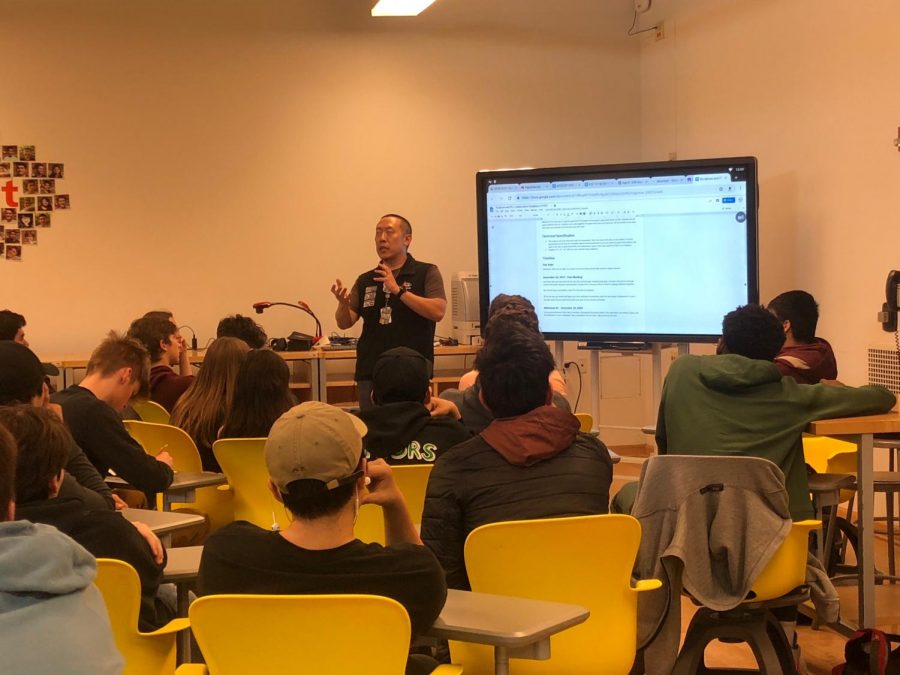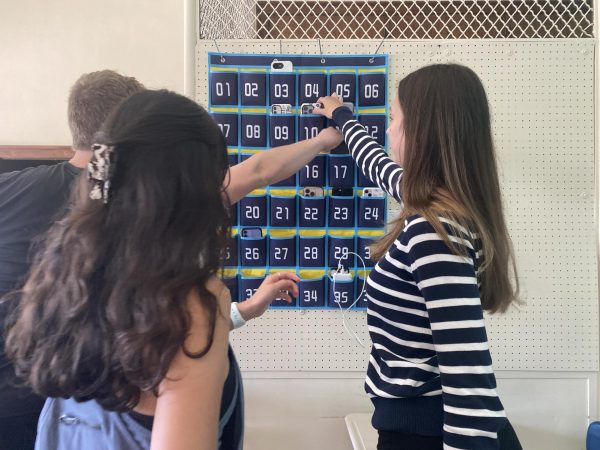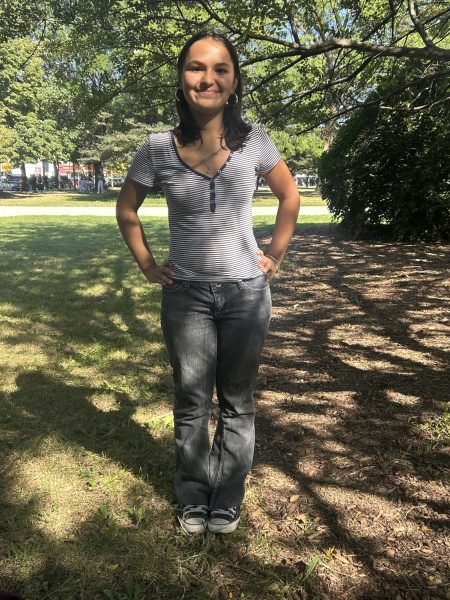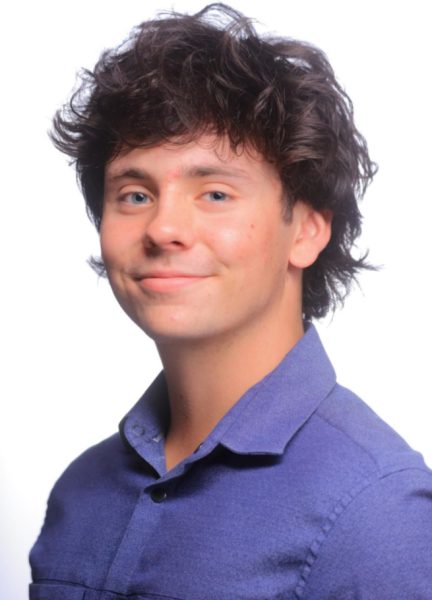CS Dept. attracts delegation of teachers from Shanghai
Physical Computing Lab students are introduced to their next project, a collaboration with Sculpture students.
A delegation of teachers and administrators from China visited the Lane Computer Science (CS) department earlier this year.
The city of Shanghai is hoping to implement a city-wide computer science rollout, according to the CS department chair, Mr. Law. If a city the size of Shanghai, which has a population of 24 million, were to implement a one-class graduation requirement as CPS has done, it would potentially be the largest computer science roll out in the world.
The computer science programs at Lane offer classes that are not seen at a high school level anywhere else in the country and have been able to produce some interesting projects with advanced equipment in the Makers Lab, according to the department website.
In an effort to learn the ins and outs of teaching computer science on such a massive scale, Shanghai sent the delegation to Chicago for a 7-week tour in September.
They visited the CPS Office of Computer Science downtown and were then sent to Lane. They thought its large student population mimics the highly populated schools in Shanghai and thought Lane’s success in teaching computer science on such a extensive scale would be appealing to them, Law said.
The delegation sat in on some classes, looked at the equipment and talked with Law about his teaching styles. Law has been at Lane for 17 years and was appointed the head of the department eight years ago.
“When you look around the country right now, a lot more schools have computer science classes but very few districts actually have it as a graduation requirement so what Chicago is doing is groundbreaking just because of the sheer size,” Law said. “So, we’re doing things at a scale that Shanghai wanted to see.”
The biggest difference between the department then and now, Law said, is the direction that the classes are taking.
“We were not a computer science department, we were a computer technology department,” said Law. “So the focus of the department was different than it is now.”
In the early 2000s, before smartphones were in everyone’s pockets, the department was teaching classes like Computer Information Technology, where students were taught how to use Microsoft Word and Excel programs and navigate the computers themselves, according to Law.
Today, the CS department offers classes like Intro to Artificial Intelligence, Cybersecurity and Microarchitecture. These accelerated courses have attracted so many students that, according to Mr. Law, their enrollment size for classes like AP Computer Science A and AP Computer Science Principles has nearly doubled in the last year alone.
“We have the most comprehensive computer science offering in the country,” Law said. “We have 1800 students in our department and we offer 13 courses and we have 12 full-time CS teachers and that’s larger than most universities.”
Not only does the department have impressive enrollment and staff, but Lane is also home to the Makers Lab. Equipped with all kinds of prototyping machines, it allowed them to add some really cool and advanced classes to the program.
It started in 2014. Mr. Solin, who has been at Lane for seven years and is one of the four original computer science teachers, first had the idea to get a few pieces of equipment for the school and see where they could take the curriculum from there. Law and Solin went to pitch the idea to assistant principal Mr. Ara.
Ara, who was looking for something to do with the old teacher cafeteria, gave them the room and proposed that they create a whole Makers Lab.
“The aim of this lab and associated course is to provide the necessary equipment and resources, commonly referred to as a maker space, maker lab and innovation lab, to teach students how to design, prototype and engineer their own innovative products and solutions to complex problems,” according to the Computer Science department website.
Solin spent the better part of the 2013-2014 school year planning, designing, and creating the Makers Lab. By the start of the 2014-2015 school year, the lab was finished and the class Innovation Creation Lab (ICL) was born.
Today, it is home to four laser cutters, ten 3D printers, seven 3D carvers, four vinyl cutters, four 3D scanners, 34 Macbook Pro laptops and many other prototyping machines, according to the Makers Lab Website.
In 2017, Solin’s ICL class was given an assignment: students were going to design a 3D “tile” and were given certain 3D vector guidelines and color assignments to follow. The goal was to make it look similar to the Chicago Flag from an aerial point of view.
The final mosaic was on display at Navy Pier for 8 months and then on display at the Museum of Science and Industry for a temporary spring break exhibit that ran until April 8, 2018.
“The creativity of my students seemed to have no limits,” Solin said in a June 2017 blog post. “I’ve learned over my 15 years of teaching to let go of my fears of having to come up with creative ideas, and remember that if the students are given the right combination of opportunities and resources, and are taught with inquiry and passion, they’ll work magic.”
In addition to classes, students who have an interest in furthering their computer science knowledge outside the classroom have come together to form the LT Makers Pro Team. They do everything from helping with improvements to the lab to assisting ICL students with projects and lab cleanup.
Club President Sadie Bunting, Div. 079, enjoys digital fabrication as well as web design and programming. With classes like ICL and Media Computation under her belt and current enrollment in Microarchitecture, she and the team were able to build 2 of the 3D printers currently in the Makers Lab.
Their goal is “to give students an opportunity to learn more and expand their understanding of makerspaces, help create and/or edit curriculum and tutorials for the resources in the lab and to volunteer at CS/LTMaker events by running workshops and helping with setup,” Bunting said in an email.
Despite the fact that the president of the pro team is female, the department still struggles with its male to female student ratio. As of last year, AP CS classes had only 27% girls, according to Mr. Law. In Solin’s Microarchitecture class, female enrollment is very slim. To him, encouraging girls to enroll in computer science classes “is a puzzle that we are constantly trying to figure out.”
“We have a very low number of girls in there. It’s been getting better but I’ve had years where I had two girls in that class and all I can think is we’re doing something wrong,” Solin said. “What we see is that in our earlier classes, there are often higher levels of gender balance across the classes and as you get into the higher technical classes, we start losing girls.”
Next year, the CS department is introducing a class called Civil Action through Computer Science, to be taught by one of the new teachers, Mr. Stone. The class will focus on solving social justice issues through computer science.
According to Solin, they are always trying to adapt the department’s programs to the needs, interests and creativity of their students. This new civil action class is just one of many ways the department tries to engage students.
“We talk a lot about how we can weave in students’ differences, cultural backgrounds, all kinds of things, how we can weave that into projects that people do so that it has more meaning to them,” Solin said.
Your donations directly fund the Lane Tech student journalism program—covering essential costs like website hosting and technology not supported by our school or district. Your generosity empowers our student reporters to investigate, write, and publish impactful stories that matter to our school community.
This website is more than a publishing platform—it's an archive, a research tool, and a source of truth. Every dollar helps us preserve and grow this resource so future students can learn from and build on the work being done today.
Thank you for supporting the next generation of journalists at Lane Tech College Prep!

Maggie is a senior at Lane. After a program at the High School Journalism Institute at Indiana University in July of 2019, she cemented her love for writing....




